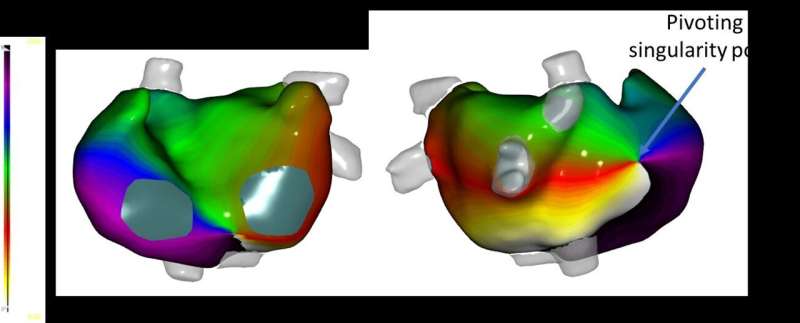This article has been reviewed according to Science X's editorial process and policies. Editors have highlighted the following attributes while ensuring the content's credibility:
fact-checked
proofread
In-office mapping of the heart without the need for surgery or CT scans for the diagnosis of cardiac arrhythmia

For almost a hundred years, the primary way to diagnose a patient with cardiac arrhythmia has been using a standard electrocardiogram (ECG). This technique allows the detection of these pathologies, but it is of little use in identifying the most appropriate treatment for each patient. In recent years, a new technology called Electrocardiographic Imaging (ECGi) has been developed, which allows the maps of cardiac activity to be viewed non-invasively, without the need for surgery or catheters. It is known as the "ECG of the 21st century."
However, it has a significant drawback: it requires the patient to have a combined CT and ECGi scan, which limits its use only to highly complex patients and in leading centers worldwide.
Now, a study by a team from the Universitat Politècnica de València (UPV) and the company Corify Care has opened a new avenue to help clinicians and make ECGi a routine clinical application tool.
In their work, published in the Journal of Electrocardiology, they evaluated the possibilities of using ECGi without CT/MRI to detect atrial fibrillation, the most common cardiac arrhythmia. More than 1 million people in Spain suffer from this arrhythmia, and there are estimated to be more than 40 million worldwide. Its approach allows patients' hearts to be located and electrical activity to be mapped quickly.
The UPV and Corify Care team analyzed surface signals from 25 patients with atrial fibrillation and compared the effect of using ECGi with imaging techniques and their proposed ECGI with an estimated cardiac geometry based on the anatomical characteristics of the patient's torso.
Their results validate non-imaging ECGi as a robust technique for the non-invasive assessment of atrial fibrillation, demonstrating that it can provide detailed information about the electrical activity of the heart in a much more comprehensive way than conventional ECGs.
"This will help to detect and diagnose cardiac arrhythmias more accurately and to plan the treatment of cardiac arrhythmias in the operating surgery room more efficiently, as it provides precise information about the location and extent of the arrhythmias," adds Dr. Maria Guillem, a researcher in the COR-Instituto ITACA group at the Universitat Politècnica de València.
Rubén Molero, also a researcher with the COR-Instituto ITACA group at the Universitat Politècnica de València, adds that in addition to reducing patients' exposure to ionizing radiation such as CT scans to obtain their cardiac geometry, this technique also reduces the time and costs of this technology, "making it more universal and facilitating its introduction into clinical practice."
This technology, patented before its publication, is being developed and is starting its commercial phases from the spin-off Corify Care, the winner, among others, of the award for best European innovation of the year 2020 by the European Institute of Innovation and Technology.
As Andreu Climent, researcher of the study and CEO of the company, points out, "the ability to obtain maps of the heart's electrical activity in a few minutes and safely allows progress, both in atrial fibrillation and in many other arrhythmias, to increase the accuracy of invasive procedures."
More information: Rubén Molero et al, Robustness of imageless electrocardiographic imaging against uncertainty in atrial morphology and location, Journal of Electrocardiology (2023). DOI: 10.1016/j.jelectrocard.2022.12.007




















